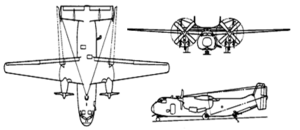PlaneSpottingWorld welcomes all new members! Please gives your ideas at the Terminal.
C-2 Greyhound
| C-2 Greyhound | |
|---|---|
| Type | carrier borne transport |
| Manufacturer | Grumman Aerospace |
| Maiden flight | 1964-11-18 |
| Introduced | 1966 |
| Retired | 1987, C-2A |
| Status | 39 C-2(R) in active service |
| Primary user | U.S. Navy |
| Produced | 1965-1968 1985-1989, C-2(R) |
| Number built | 58 |
| Unit cost | US$38.96 million |
| Developed from | E-2 Hawkeye |
The C-2A Greyhound is a twin-engine cargo aircraft, designed to provide critical logistics support to aircraft carriers of the United States Navy. Its primary mission is Carrier Onboard Delivery (COD).
Development
The C-2 Greyhound is a derivative of the E-2 Hawkeye and replaced the piston-engined C-1 Trader in the Carrier Onboard Delivery role. The C-2 shares wings, power plants and empennage with the E-2 Hawkeye, but has a widened fuselage with a rear loading ramp. The first of two prototypes flew in 1964 and production began the following year. The original C-2A aircraft were overhauled to extend their operational life in 1973. In 1984, a contract was awarded for 39 new C-2A aircraft to replace older airframes. Dubbed the Reprocured C-2A or C-2A(R) due to the similarity to the original, the new aircraft includes substantial improvements in airframe and avionic systems. All the older C-2As were phased out in 1987, and the last of the new models was delivered in 1990.
Service
Powered by two Allison T56 turboprop engines, the C-2A can deliver a payload of up to 10,000 pounds (4,500 kg). The cabin can readily accommodate cargo, passengers or both. It is also equipped to accept litter patients in medical evacuation missions. Priority cargo such as jet engines can be transported from shore to ship in a matter of hours. A cage system or transport stand provides cargo restraint for loads during carrier launch or landing. The large aft cargo ramp and door and a powered winch allow straight-in rear cargo loading and unloading for fast turnaround. The C-2A's open-ramp flight capability allows airdrop of supplies and personnel from a carrier-launched aircraft. This, plus its folding wings and an on-board auxiliary power unit for engine starting and ground power self-sufficiency in remote areas provide an operational versatility found in no other cargo aircraft.
Between November 1985 and February 1987 VR-24, operating with seven Reprocured C-2As, demonstrated the aircraft's exceptional operational readiness. The squadron delivered two million pounds (900 t) of cargo, two million pounds (900 t) of mail and 14,000 passengers in support of the European and Mediterranean theatres. The C-2A(R) also provided support to the carrier battle groups during Operations Desert Shield and Desert Storm, as well as currently during Operation Enduring Freedom.
The entire fleet of 36 C-2A(R)s are currently undergoing a Critical Service Life Extension Program (SLEP) to extend their operational lifespan. The lifespan of the C-2A(R) was 10,000 hours total time, or 15,000 carrier landings; current plans require the C-2A to perform its mission supporting battle group operational readiness through 2015. The landing limit is quickly approaching for most of the airframes, and the SLEP will increase the Greyhound's projected life to 15,000 hours total time or 36,000 landings. Once the program is complete, it will allow the current 36 aircraft to operate until 2027. The SLEP includes a structural enhancement of the center wing, significant navigational upgrades including the addition of GPS and the dual CAINS II Navigation System, the addition of crash survivable flight incident recorders, and a Ground Proximity Warning System. The first upgraded C-2A(R) left NAVAIR Depot North Island on September 12, 2005, after sitting on the ground for three and a half years while the SLEP was developed and installed. A second airframe is currently nearing completion and it is anticipated that the remaining 34 aircraft will all undergo the SLEP upgrade within the next five years as operations and schedule permit.
There are no plans to replace the C-2A(R) fleet, and no replacement aircraft are currently in development.
Specifications (Reprocured C-2A)
Data from NAVAIR Performance Summary[1]
General characteristics
- Crew: two pilots
- Capacity: 26 passengers, 12 litter patients
- Payload: 10,000 lb (4,536 kg)
- Length: 56 ft 10 in (17.30 m)
- Wingspan: 80 ft 7 in (24.60 m)
- Height: 15 ft 10½ in (4.85 m)
- Wing area: 700 ft² (65 m²)
- Empty weight: 33,746 lb (15,310 kg)
- Loaded weight: 49,394 lb (22,405 kg)
- Useful load: 20,608 lb (9,350 kg)
- Max takeoff weight: 54,354 lb (24,655 kg)
- Powerplant: 2× Allison T56-A-425 turboprops, 4,591 shp (3,400 kW) each
Performance
- Maximum speed: 300 knots (345 mph, 553 km/h) at 12,000 ft (3,660 m)
- Cruise speed: 251 knots (289 mph, 465 km/h) at 28,700 ft (8,750 m)
- Stall speed: 82 knots (94 mph, 152 km/h) at idle power
- Range: 1,300 nm (1,496 mi, 2,400 km)
- Service ceiling: 33,500 ft (10,210 m)
- Rate of climb: 2,610 ft/min (13.3 m/s)
- Wing loading: 77.6 lb/ft² (378.9 kg/m²)
References
- ↑ NAVAIR (November 1984). Performance Summary. Standard Aircraft Characteristics, Reprocured C-2A. Retrieved on 2006-05-12.
Related content
Related development
Comparable aircraft
Designation sequence
See also
Lists relating to aviation | |
|---|---|
| General | Timeline of aviation · Aircraft · Aircraft manufacturers · Aircraft engines · Aircraft engine manufacturers · Airports · Airlines |
| Military | Air forces · Aircraft weapons · Missiles · Unmanned aerial vehicles (UAVs) · Experimental aircraft |
| Notable incidents and accidents | Military aviation · Airliners · General aviation · Famous aviation-related deaths |
| Records | Flight airspeed record · Flight distance record · Flight altitude record · Flight endurance record · Most produced aircraft |


